Bata Shoes
|
| |
| Private company | |
| Industry | Retail and Manufacturing |
| Founded | August 24, 1894 in Zlín, Czech Republic |
| Founder | Tomáš Baťa |
| Headquarters | Lausanne, Switzerland |
Area served | Europe, Africa, Asia, Latin America |
Key people |
Christopher Kirk (Chairman) Alexis Nasard (CEO) |
| Products | Footwear, Clothing and Accessories |
| Owner | Bata Family |
| Website |
www |
Bata (also known as Bata Shoe Organization) is a family-owned global footwear and fashion accessory manufacturer and retailer with acting headquarters located in Lausanne, Switzerland. Organized into three business units: Bata Europe, based in Italy; Bata Emerging Market (Asia, Pacific, Africa and Latin America), based in Singapore, and Bata Protective (worldwide B2B operations), based in the Netherlands, the organization has a retail presence of over 5200 retail stores in more than 70 countries and production facilities in 18 countries.
Origins and history
Foundation
The T. & A. Baťa Shoe Company was founded on the 24th of August 1894 in Zlín (Moravia, today the Czech Republic) by Tomáš Baťa (Czech: [ˈtomaːʃ ˈbaca]), his brother Antonín and his sister Anna, whose family had been cobblers for generations. The company employed 10 full-time employees with a fixed work schedule and a regular weekly wage, a rare find in its time.
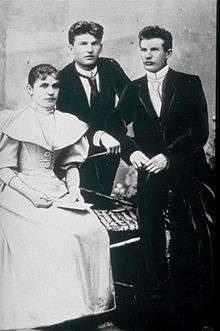
In the summer of 1895, Tomáš found himself facing financial difficulties, and debts abounded. To overcome these serious setbacks, Tomáš decided to sew shoes from canvas instead of leather. This type of shoe became very popular and helped the company grow to 50 employees. Four years later, Bata installed its first steam-driven machines, beginning a period of rapid modernisation. In 1904, Tomáš read a newspaper article about some machines being made in America. Therefore, he took three workers and journeyed to Lynn, a shoemaking city outside Boston, in order to study and understand the American system of mass production. After six months Tomáš returned to Zlin and he introduced mechanized production techniques that allowed the Bata Shoe Company to become one of the first mass producers of shoes in Europe. Its first mass product, the “Batovky,” was a leather and textile shoe for working people that was notable for its simplicity, style, light weight and affordable price. Its success helped fuel the company’s growth. After Antonin's death in 1908, Tomas brought two of his younger brothers, Jan and Bohuš, into the business. Initial export sales and the first ever sales agencies began in Germany in 1909, followed by the Balkans and the Middle East. Bata shoes were considered to be excellent quality, and were available in more styles than had ever been offered before. By 1912, Bata was employing 600 full-time workers, plus another several hundred who worked out of their homes in neighbouring villages.
World War I
In 1914, with the outbreak of World War I, the company had a significant development due to military orders. From 1914 to 1918 the number of Baťa’s employees increased ten times. The company opened its own stores in Zlín, Prague, Liberec, Vienna and Pilsen, among other towns.
In the global economic slump that followed World War I, the newly created country of Czechoslovakia was particularly hard hit. With its currency devalued by 75%, demand for products dropped, production was cut back, and unemployment was at an all-time high. Tomáš Baťa responded to the crisis by cutting the price of Bata shoes in half. The company’s workers agreed to a temporary 40 percent reduction in wages; in turn, Bata provided food, clothing, and other necessities at half-price. He also introduced one of the first profit sharing initiative transforming all employees into associates with a shared interest in the company's success (today's equivalent of performance-based incentives and stock options).
Shoemaker to the world
Consumer response to the price drop was dramatic. While most competitors were forced to close because of the crisis in demand between 1923 and 1925, Bata was expanding as demand for the inexpensive shoes grew rapidly. The Bata Shoe Company increased production and hired more workers. Zlín became a veritable factory town, a "Bataville" covering several hectares. On the site were grouped tanneries, a brickyard, a chemical factory, a mechanical equipment plant and repair shop, workshops for the production of rubber, a paper pulp and cardboard factory (for production of packaging), a fabric factory (for lining for shoes and socks), a shoe-shine factory, a power plant and a farming activities to cover both food and energy needs... Horizontal and vertical integration. Workers, "Batamen", and their families had at their disposal all the necessary everyday life services: housing, shops, schools, hospital, etc.
| The T. & A. Baťa Shoe Company | ||||||||||||||
|---|---|---|---|---|---|---|---|---|---|---|---|---|---|---|
|
International growth


Bata also began to build towns and factories outside of Czechoslovakia (Poland, Latvia, Romania, Switzerland, France) and to diversify into such industries as tanning (1915), the energy industry (1917), agriculture (1917), forest farming (1918), newspaper publishing (1918), brick manufacturing (1918), wood processing (1919), the rubber industry (1923), the construction industry (1924), railway and air transport (1924), book publishing (1926), the film industry (1927), food processing (1927), chemical production (1928), tyre manufacturing (1930), insurance (1930), textile production (1931), motor transport (1930), sea transport (1932), and coal mining (1932). Airplane manufacturing (1934), synthetic fibre production (1935), and river transport (1938). In 1923 the company boasted 112 branches.
In 1924 Tomáš Baťa displayed his business acumen by figuring out how much turnover he needed to make with his annual plan, weekly plans and daily plans. Baťa utilized four types of wages – fixed rate, individual order based rate, collective task rate and profit contribution rate. He also set what became known as Baťa prices – numbers ending with a nine rather than with a whole number. His business skyrocketed. Soon Baťa found himself the fourth richest person in Czechoslovakia. From 1926 to 1928 the business blossomed as productivity rose 75 percent and the number of employees increased by 35 percent. In 1927 production lines were installed, and the company had its own hospital. By the end of 1928, the company’s head factory was composed of 30 buildings. Then the entrepreneur created educational organizations such as the Baťa School of Work and introduced the five-day work week. In 1930 he established a stunning shoe museum that maps shoe production from the earliest times to the contemporary age throughout the world. By 1931 there were factories in Germany, England, the Netherlands, Poland and in other countries.
In 1932, at the age of 56, Tomáš Baťa died in a plane crash during take off under bad weather conditions at Zlín Airport. Control of the company was passed to his half-brother, Jan, and his son, Thomas John Bata, who would go on to lead the company for much of the twentieth century guided by their father’s moral testament: the Bata Shoe company was to be treated not as a source of private wealth, but as a public trust, a means of improving living standards within the community and providing customers with good value for their money. Promise was made to pursue the entrepreneurial, social and humanitarian ideals of their father. The Baťa company was apparently the first big enterprise to systematically utilise aircraft for company purposes, including rapid transport of lesser personnel on business like delivery of maintenance men and spares to a location where needed, originating the practice of business flying.
Jan Antonín Baťa
At the time of Tomáš's death, the Bata company employed 16,560 people, maintained 1,645 shops and 25 enterprises. Jan Baťa, following the plans laid down by Tomáš Baťa before his death, expanded the company more than six times its original size throughout Czechoslovakia and the world. Plants in Britain, the Netherlands, Yugoslavia, Brazil, Kenya, Canada and the United States, followed in the decade. In India, Batanagar was settled near Calcutta and accounted from the late 1930s nearly 7500 Batamen. The Bata model fitted anywhere, creating, for example, canteens for vegetarians in India. In exchange, the demands on workers were as strong as in Europe: "Be courageous. The best in the world is not good enough for us. Loyalty gives us prosperity & happiness. Work is a moral necessity!" Bata India was incorporated as Bata Shoe Company Pvt. Ltd in 1931[1] and went on to become Bata India Ltd. in 1973. Batanagar factory is the first Indian shoe manufacturing unit to receive the ISO 9001 certification in 1993.[2]
As of 1934, the firm owned 300 stores in North America, a thousand in Asia, more than 4,000 in Europe. In 1938, the Group employed just over 65,000 people worldwide, including 36% outside Czechoslovakia and had stakes in the tanning, agriculture, newspaper publishing, railway and air transport, textile production, coal mining and aviation realms.
Bata-villes
Company policy initiated under Tomáš Baťa was to set up villages around the factories for the workers and to supply schools and welfare. These villages include Batadorp in the Netherlands, Baťovany (present-day Partizánske) and Svit in Slovakia, Baťov (now Bahňák, part of Otrokovice) in the Czech Republic, Borovo-Bata (now Borovo Naselje, part of Vukovar in Croatia then in the Kingdom of Yugoslavia), Bata Park in Möhlin, Switzerland, Bataville in Lorraine, France, Batawa in Canada, East Tilbury[3] in Essex, England, Batapur in Pakistan and Batanagar and Bataganj in India. There was also a factory in Belcamp, Maryland, USA, northeast of Baltimore on U.S. Route 40 in Harford County.[4]
The British "Bata-ville" in East Tilbury inspired the documentary film Bata-ville: We Are Not Afraid of the Future.[5]
World War II
Just before the German occupation of Czechoslovakia, Baťa helped re-post his Jewish employees to branches of his firm all over the world.[6][7] Germany occupied the remaining part of pre-war Czechoslovakia on 15 March 1939; Jan Antonín Baťa then spent a short time in jail but was then able to leave the country with his family. Jan Antonín Baťa stayed in America from 1939–1940, but when the USA entered the war, he felt it would be safer for his co-workers and their families back in occupied Czechoslovakia if he left the United States. He was put on British and US black lists for doing business with the Axis powers, and in 1941 he emigrated to Brazil. After the war ended, the Czechoslovak authorities tried Baťa as a traitor, saying he had failed to support the anti-Nazi resistance. In 1947 he was sentenced in absentia to 15 years in prison. The company's Czechoslovak assets were also seized by the state – several months before the Communists came to power. He tried to save as much as possible of the business, submitting to the plans of Germany as well as financially supporting the Czechoslovak Government-in-Exile led by Edvard Beneš.
In occupied Europe a Bata shoe factory was connected to the concentration camp Auschwitz-Birkenau.[8] The first slave labour efforts in Auschwitz involved the Bata shoe factory.[9] In 1942 a small camp was established to support the Bata shoe factory at Chełmek with Jewish slave labourers.[10]
Post-war
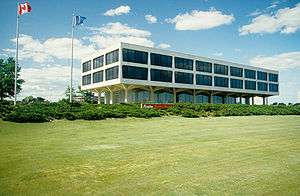
Tomáš's son Thomas manager of the buying department of the English Bata Company was unable to return until after the war. He was sent to Canada by his uncle Jan, to become the Vice President of the Bata Import and Export Company of Canada, which was founded in a company town named Batawa, opened in 1939. Foreign subsidiaries were separated from the mother company, and ownership of plants in Bohemia and Moravia was transferred to another member of the family.
After World War II, governments in Czechoslovakia, East Germany, Poland and Yugoslavia confiscated and nationalized Bata factories, stripping Bata of its Eastern European assets. From its new base in Canada, the company gradually rebuilt itself, expanding into new markets throughout Asia, the Middle East, Africa and Latin America. Rather than organizing these new operations in a highly centralized structure, Bata established a confederation of autonomous units that could be more responsive to new markets in developing countries.
In 1964, the Bata Shoe Organisation moved their headquarters to Toronto, Ontario, Canada — and in 1965 moved again, into an ultra-modern building, the Bata International Centre. The building, located on Wynford Drive, in suburban North York was designed by architect John B. Parkin.
Bata was one of the official sponsors of the 1986 FIFA World Cup held in Mexico. Bata also sponsored 2014 Electronic Sports World Cup.[11]
Czechoslovakia after 1989
After the Velvet Revolution in November 1989, Thomas J. Baťa arrived as soon as December 1989. The Czechoslovak government offered him the opportunity to invest in the ailing government-owned Svit shoe company. Since companies nationalised before 1948 were not returned to their original owners, the state continued to own Svit and privatised it during voucher privatisation in Czechoslovakia. Svit's failure to compete in the free market led to decline, and in 2000 Svit went bankrupt.
Present
After the global economic changes of the 1990s, the company closed a number of its manufacturing factories in developed countries and focused on expanding retail business. Bata moved out of Canada in several steps. In 2000, it closed its Batawa factory. In 2001, it closed its Bata retail stores, retaining its "Athletes World" retail chain. In 2004, the Bata headquarters were moved to Lausanne, Switzerland and leadership was transferred to Thomas G. Bata, grandson of Tomáš Baťa. The Bata headquarters building in Toronto was vacated and eventually demolished to much controversy. In 2007, the Athletes World chain was sold, ending Bata retail operations in Canada.[12] As of 2013, Bata maintains the headquarters for its "Power" brand of footwear in Toronto. The Bata Shoe Museum, founded by Sonja Bata, and operated by a charitable foundation, is also located in Toronto.
Although no longer chairman of the company, the elder Mr. Bata remained active in its operations and carried business cards listing his title as “chief shoe salesman.” In 2008, Thomas John Bata died at Sunnybrook Health Sciences Centre in Toronto at the age of 93.
Bata estimates that it serves more than 1 million customers per day, employing over 30,000 people,[13] operates more than 5,000 retail stores, manages 27 production facilities and a retail presence in over 90 countries mostly in Asia, Europe and Australia. Bata has a strong presence in countries like India where it has been in existence since 1931. Bata India has five factories and two tanneries. The Mokameh Ghat tannery in Bihar (1952) is the second largest in Asia.[14] Singapore is home to BATA Asia Pacific and Africa operations and manages close to 3,000 outlets in the region. In Singapore, there are more than 40 stores.

Bata brands
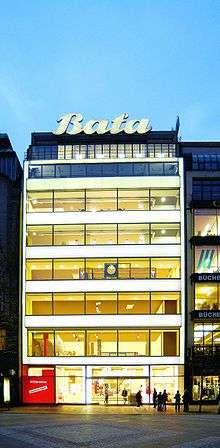
- Baťa (Baťa in the Czech Republic and Slovakia)
- Bata Comfit (comfort shoes)
- Ambassador (classic men's shoes)
- North Star (urban shoes)
- Weinbrenner (premium outdoor shoes)
- Marie Claire (women's shoes)
- SunDrops (women's shoes)
- Bubblegummers (children's shoes)
- Baby Bubbles (children's shoes)
- Safari (desert shoes)
- Power (athletic shoes)
- Patapata (flip flops)
- Toughees (school shoes)
- Verlon (school shoes)
- Teener (school shoes)
- B-First (school shoes)
- Footin (trendy shoes)
- Bata Industrials (work & safety footwear)
- SPARX (sport shoes)
- B.First (sport shoes)
In popular culture
- The 1968 Czech film All My Compatriots by Vojtěch Jasný, in a scene set in 1948, refers to Bata putting small shoemakers out of business.
- In Susan Elderkin's 2000 novel Sunset Over Chocolate Mountains one of the three narrative voices is Eva, a worker in a Bata factory in Partizánske, Slovakia.[15]
- Emil Zátopek worked in a Bata factory in Zlín.
- Bata-ville: We are not afraid of the future is a 2005 documentary produced and directed by the charming artistic duo Karen Guthrie and Nina Pope that documents a party of former UK Bata workers on a coach trip to the headquarters of the company at Zlín.[16]
See also
References
- ↑ "Bata India - Buy Shoes Online For Men, Women & Kids. Footwear From Leading Brands, Power, Hush Puppies etc". bata.in.
- ↑ "Categories". bata.in.
- ↑ "batamemories". Archived from the original on 19 November 2002. Retrieved 10 December 2013.
- ↑ "Bata Shoe Factory Belcamp Maryland". Kilduffs.com. Retrieved 2013-11-19.
- ↑ "Entertainment | Road film follows shoe empire". BBC News. 2005-08-28. Retrieved 2013-11-19.
- ↑
- ↑ Stephen Moss (2002-06-22). "Profile: Tom Stoppard | Film". London: The Guardian. Retrieved 2013-11-19.
- ↑ Dwork, Deborah; van Pelt, Robert Jan, Holocaust: A History, W.W.Norton & Company, Inc., 2002. ISBN 9780393051889
- ↑ Engle Schafft, Gretchen, From Racism to Genocide: Anthropology in the Third Reich, University of Illinois Press, 2004. ISBN 0-252-02930-5
- ↑ Dwork, Deborah; van Pelt, Robert Jan, Auschwitz: 1270 to the Present, New York: W.W. Norton and Company Inc. ISBN 0-393-03933-1
- ↑ "Bata Announces Sponsorship Deal with eSports Team". bata.com. Retrieved 2015-01-22.
- ↑ Strauss, Marina (May 18, 2007). "Mogul snaps up Athletes World". The Globe and Mail. p. B3.
- ↑ About Bata bata.com, March 5, 2013.
- ↑ http://www.bataindia.com/corporate.htm
- ↑ Matthew J. Reynolds. "Review: A Slovak-Arizona journey - The Slovak Spectator". Spectator.sme.sk. Retrieved 2013-11-19.
- ↑ "Bata-ville: We Are Not Afraid of the Future (2005)". IMDb. 1 April 2005.
External links
![]() Media related to Bata Shoes at Wikimedia Commons
Media related to Bata Shoes at Wikimedia Commons
- Bata Shoes Worldwide
- Bata Memories history of Bata community in Essex, UK
- "Bata-ville – We are not afraid of the future": somewhere.org.uk/bata-ville / bata-ville.com, Somewhere, 2007 United Kingdom "Against the backdrop of economic regeneration, former employees of two now closed UK Bata factories are led on a unique journey through Bata's legacy and across a changing Europe."
- Bata Industrials
.jpg)

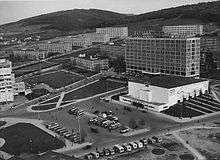
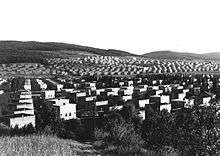
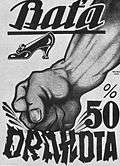

.jpg)